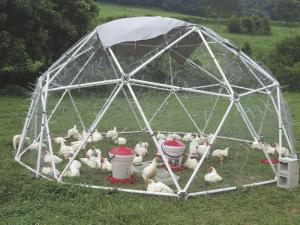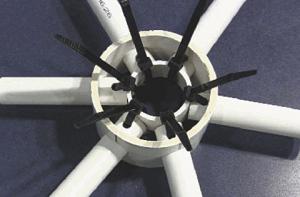"Zip Tie" Chicken Domes, Greenhouses
If you can work with 1-in. pvc pipe and close a zip tie, you can build a geodesic dome portable chicken coop or greenhouse. What really sets Zip Tie DomeTM kits apart is the connecting hub designed by John Hurt. The struts (1-in. pipe sections) that form the triangles slip into holes on a 4-in. pvc collar around the hub. Heavy-duty zip ties (120-lb. tension) slip through holes in the pipes and around the hub for a secure connection.
Within a couple of hours, one or two people can assemble a frame for a 16-ft. diameter dome with an 8-ft. tall center. In another couple of hours they can zip tie chicken wire over the surface and a tarp on top to complete a 113-lb. Jumbo Coop, with enough room for 50 to 100 chickens.
That’s about half the weight of a typical mobile chicken coop built out of wood, Hurt says, which is why he came up with the idea.
His family liked the idea of raising chickens on pasture. But the first coops they made were too heavy to pull by hand and not tall enough to stand up inside. Pvc structures are not a new idea, but ordinary plumbing connectors crack and break under the stress of frequent moving.
“My hub design has lots of flexibility,” Hurt says. And it can be easily adjusted if a pipe breaks and needs to be replaced. After a couple years of testing, and with a patent pending on the hub connector design, Zip Tie Domes went on the market last May.
Hurt, his wife, Carolyn, and their six sons fabricate the parts on the family’s Buffalo Valley, Tenn., property. Currently they offer three sizes: Small (10 ft., $295), Medium (13 ft., $325) and Jumbo (16 ft., $365). Prices include shipping, and kits include all the struts (with two extra to create a door), connectors and zip ties for the frame and attaching chicken wire. The dome kits come with a 90-day, no-questions-asked return policy and a 2-year warranty.”
Customers buy the chicken wire, tarp and whatever they need to secure it to the ground locally. The Hurts place two concrete blocks on opposite ends and secure them to the dome with bungee cords. Just unhook the blocks when moving the dome, then secure them again, Hurt says.
He adds the shape works well for housing chickens, as they never get trapped in a corner.
The domes also make great greenhouses, and the Hurts made a smaller version for a dog house next to the chickens to acclimate a Pyrenees puppy that will be their future guardian.
Hurt expects there will be many more applications for his domes, which excites him.
“Our philosophy is that this is more than just a business,” he says. “Zip Tie Domes is what we do to improve the lives of other people.”
The business’s website includes several videos that show how to assemble the domes.
Contact: FARM SHOW Followup, Zip Tie Domes, 1857 Brindley Hollow Rd., Buffalo Valley, Tenn. 38548 (ph 931 858-6892; contact@ziptiedomes.com; www.ziptiedomes.com).

Click here to download page story appeared in.
Zip Tie Chicken Domes Greenhouses LIVESTOCK Miscellaneous If you can work with 1-in pvc pipe and close a zip tie you can build a geodesic dome portable chicken coop or greenhouse What really sets Zip Tie DomeTM kits apart is the connecting hub designed by John Hurt The struts 1-in pipe sections that form the triangles slip into holes on a 4-in pvc collar around the hub Heavy-duty zip ties 120-lb tension slip through holes in the pipes and around the hub for a secure connection Within a couple of hours one or two people can assemble a frame for a 16-ft diameter dome with an 8-ft tall center In another couple of hours they can zip tie chicken wire over the surface and a tarp on top to complete a 113-lb Jumbo Coop with enough room for 50 to 100 chickens That’s about half the weight of a typical mobile chicken coop built out of wood Hurt says which is why he came up with the idea His family liked the idea of raising chickens on pasture But the first coops they made were too heavy to pull by hand and not tall enough to stand up inside Pvc structures are not a new idea but ordinary plumbing connectors crack and break under the stress of frequent moving “My hub design has lots of flexibility ” Hurt says And it can be easily adjusted if a pipe breaks and needs to be replaced After a couple years of testing and with a patent pending on the hub connector design Zip Tie Domes went on the market last May Hurt his wife Carolyn and their six sons fabricate the parts on the family’s Buffalo Valley Tenn property Currently they offer three sizes: Small 10 ft $295 Medium 13 ft $325 and Jumbo 16 ft $365 Prices include shipping and kits include all the struts with two extra to create a door connectors and zip ties for the frame and attaching chicken wire The dome kits come with a 90-day no-questions-asked return policy and a 2-year warranty ” Customers buy the chicken wire tarp and whatever they need to secure it to the ground locally The Hurts place two concrete blocks on opposite ends and secure them to the dome with bungee cords Just unhook the blocks when moving the dome then secure them again Hurt says He adds the shape works well for housing chickens as they never get trapped in a corner The domes also make great greenhouses and the Hurts made a smaller version for a dog house next to the chickens to acclimate a Pyrenees puppy that will be their future guardian Hurt expects there will be many more applications for his domes which excites him “Our philosophy is that this is more than just a business ” he says “Zip Tie Domes is what we do to improve the lives of other people ” The business’s website includes several videos that show how to assemble the domes Contact: FARM SHOW Followup Zip Tie Domes 1857 Brindley Hollow Rd Buffalo Valley Tenn 38548 ph 931 858-6892; contact@ziptiedomes com; www ziptiedomes com







